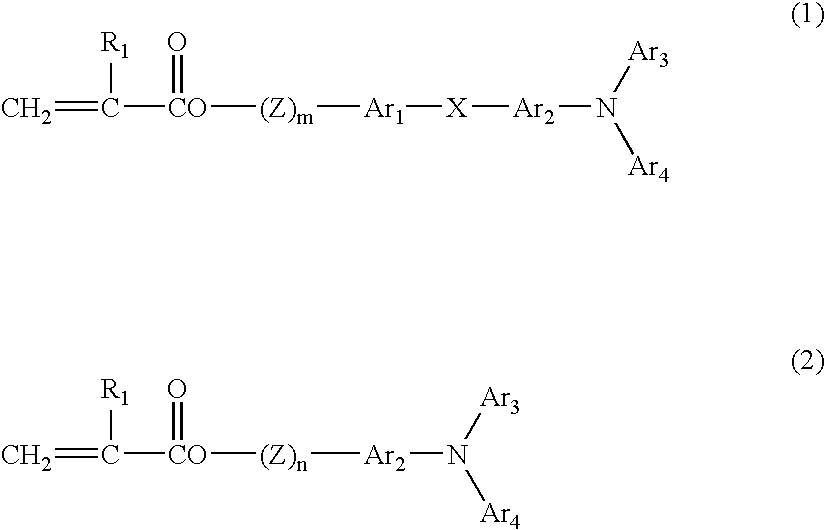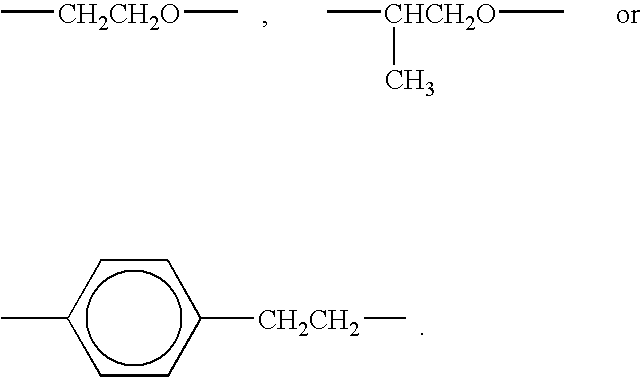Electrophotographic photoconductor, and image forming process, image forming apparatus and process cartridge for an image forming apparatus using the same
a photoconductor and photoconductor technology, applied in the direction of electrographic process apparatus, instruments, corona discharge, etc., can solve the problems of sensitivity and chargeability, deterioration of electrical properties, and abrasion resistan
- Summary
- Abstract
- Description
- Claims
- Application Information
AI Technical Summary
Problems solved by technology
Method used
Image
Examples
example a-1
[0250] On a .phi.30 mm aluminum cylinder, a coating solution for a under coating layer, a coating solution for a charge generation layer, a coating solution for a charge transport layer, each coating solution has a composition described below, were sequentially applied and dried to form a under coating layer of 3.5 .mu.m, a charge generation layer of 0.2 .mu.m and a charge transport layer of 18 .mu.m. On the charge transport layer, a coating solution for a surface crosslinked layer of a composition described below was spray coated, irradiated under conditions of a metal halide lamp: 160 W / cm, irradiation distance: 120 mm, irradiation intensity: 500 mW / cm.sup.2, irradiation time: 20 seconds, and further dried at 130.degree. C. for 20 to prepare a surface cross-linked layer of 4 .mu.m. Thus, an electrophotographic photoconductor according to the present invention is formed.
[0251] [Coating Solution for a Under Coating Layer]
3 Alkyde resin 6 parts (Bekozole 1307-60-EL, DAINIPPON INK AND...
example a-2
[0255] An electrophotographic photoconductor was prepared following the procedures in Example A-1 except that the tri- or more-functional radical polymerizable monomer without having a charge transporting structure contained in the coating solution for a surface crosslinked layer of Example A-1 was substituted with the following monomer.
7 Tri- or more-functional radical polymerizable monomer 10 parts without having a charge transporting structure Ditrimethylolpropane tetraacrylate (SR-355, Sartomer Company Inc.) Molecular weight: 466, number of functional group: 4 functionality, molecular weight / number of functional group = 117
example a-3
[0256] An electrophotographic photoconductor was prepared following the same procedures as in Example A-1 except that the tri- or more-functional radical polymerizable monomer without having a charge transporting structure contained in the coating solution for a surface crosslinked layer of Example A-1 was substituted with the following 2-component monomer and the photopolymerization initiator was substituted with the following compound.
8 Tri- or more-functional radical polymerizable monomer 6 parts without having a charge transporting structure Pentaerythritol tetraacrylate (SR-295, Sartomer Company Inc.) Molecular weight: 352, number of functional group: 4 functionality, molecular weight / number of functional group = 88 Tri- or more-functional radical polymerizable monomer 4 parts without having a charge transporting structure Alkyl-modified dipentaerythritol triacrylate (KAYARAD D-330, Nippon Kayaku Co., Ltd.) Molecular weight: 584, number of functional group: 3 functionality, mol...
PUM
 Login to View More
Login to View More Abstract
Description
Claims
Application Information
 Login to View More
Login to View More - R&D
- Intellectual Property
- Life Sciences
- Materials
- Tech Scout
- Unparalleled Data Quality
- Higher Quality Content
- 60% Fewer Hallucinations
Browse by: Latest US Patents, China's latest patents, Technical Efficacy Thesaurus, Application Domain, Technology Topic, Popular Technical Reports.
© 2025 PatSnap. All rights reserved.Legal|Privacy policy|Modern Slavery Act Transparency Statement|Sitemap|About US| Contact US: help@patsnap.com



